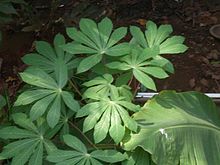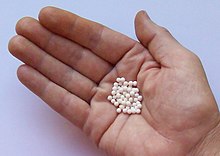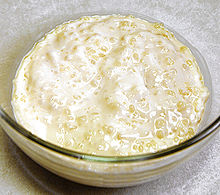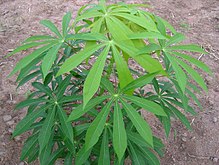Tapioca: Difference between revisions
Spelling |
Deleted the section on →Northern India: because it erroneously talks about "Sabudana", which is "Pearl Sago" made from a different plant (Metroxylon sagu) Tag: section blanking |
||
| Line 94: | Line 94: | ||
The cultivation of tapioca is manpower intensive only at the time of plantation and harvest. It provides a steady income to the farmers. Tapioca called ''maravallikilangu'' can be consumed raw (after removing the skins/outer cover). It can also be boiled and different dishes like Uppuma (Tamil) can be made. It can also be made into chips to use as snacks during tea time. |
The cultivation of tapioca is manpower intensive only at the time of plantation and harvest. It provides a steady income to the farmers. Tapioca called ''maravallikilangu'' can be consumed raw (after removing the skins/outer cover). It can also be boiled and different dishes like Uppuma (Tamil) can be made. It can also be made into chips to use as snacks during tea time. |
||
=====Northern India===== |
|||
During the festival season in Northern India, Sabudana is usually consumed during Fasts (Vrat in Hindi), either prepared as a "[[Khichdi]]" "([[खिचडी]])" (savory) [[Sabudana Khichadi]] ([[साबुदाणा खिचडी]]) or Kheer [[खीर]] (sweet). In the Holi (festival), the most popular is Sabudana papad (साबुदाणा पापड)(fried in Desi ghee). |
|||
Tapioca is also referred to as "Poor Man's Food." |
|||
=====Northeast India===== |
=====Northeast India===== |
||
Revision as of 01:48, 18 July 2013
This article has multiple issues. Please help improve it or discuss these issues on the talk page. (Learn how and when to remove these template messages)
No issues specified. Please specify issues, or remove this template. |


Tapioca (Portuguese pronunciation: [tɐpiˈɔkɐ]) is a starch extracted from Manioc (Manihot esculenta). This species is native to the Northeast of Brazil but spread throughout the South American continent. The plant was spread by Portuguese and Spanish explorers to most of the West Indies, Africa and Asia, including the Philippines and Taiwan, being now cultivated worldwide.
In Brazil, the plant (cassava) is named "mandioca", while its starch is called "tapioca". The name tapioca is derived from the word tipi'óka, the name for this starch in the Tupí language, which was spoken by the natives when the Portuguese first arrived in the Northeast of Brazil.[1] This Tupí word refers to the process by which the starch is made edible. However, as the word moved out of Brazil it came to refer to similar preparations made with other esculents.[citation needed]
In the Philippines, tapioca is usually confused with sago, as the sap of the sago palm is often part of its preparation. In India, the term "tapioca" is used to represent the root of the plant (cassava), rather than the starch.[2] In Vietnam, it is called bột năng. In Indonesia, it is called singkong. In Malaysia it is called "Ubi Kayu". In Britain, the word tapioca often refers to a milk pudding thickened with arrowroot.[citation needed]
Tapioca is a staple food in some regions and is used worldwide as a thickening agent in various foods. It is considered a gluten-free food.[3]
Production



The cassava plant has either red or green branches with blue spindles on them. The root of the green-branched variant requires treatment to remove linamarin, a cyanogenic glycoside occurring naturally in the plant, which otherwise may be converted into cyanide.[4] Konzo (also called mantakassa) is a paralytic disease associated with several weeks of almost exclusive consumption of insufficiently processed bitter cassava. The toxin found in the root of the red-branched variant is less harmful to humans than the green-branched variety.[citation needed] Therefore, the root of the red/purple-branched variant can be consumed directly.[citation needed]
In the North and Northeast of Brazil, traditional community based production of tapioca is a by-product of manioc flour production from cassava roots. In this process, the manioc (after treatment to remove toxicity) is ground to a pulp with a small hand- or diesel-powered mill. This masa is then squeezed to dry it out. The wet masa is placed in a long woven tube called a tipiti. The top of the tube is secured while a large branch or lever is inserted into a loop at the bottom and used to stretch the entire implement vertically, squeezing a starch-rich liquid out through the weave and ends. This liquid is collected and the water allowed to evaporate, leaving behind a fine-grained tapioca powder similar in appearance to corn starch.
Commercially, the starch is processed into several forms: hot soluble powder or meal or pre-cooked fine or coarse flakes, rectangular sticks, and spherical "pearls".[5] Pearls are the most widely available shape; sizes range from about 1 mm to 8 mm in diameter, with 2–3 mm being the most common.
Flakes, sticks, and pearls must be soaked well before cooking, in order to rehydrate, absorbing water up to twice their volume. After rehydration, tapioca products become leathery and swollen. Processed tapioca is usually white, but sticks and pearls may be colored. Since old times, the most common color applied to tapioca has been brown, but recently pastel colors have been available. Tapioca pearls are generally opaque when raw, but become translucent when cooked in boiling water.
Brazil in South America, Thailand in Asia, and Nigeria in Africa are the world's largest producers of cassava. Currently, Thailand accounts for about 60% of worldwide exports.[6]
Uses
Americas
Brazil
In Brazilian cuisine, tapioca is used for different types of meals. In beiju (or biju), the tapioca is moistened, strained through a sieve to become a coarse flour, then sprinkled onto a hot griddle or pan, where the heat makes the starchy grains fuse into a flatbread, which may be sprinkled with coconut. Then it may be buttered and eaten as a toast (its most common use as a breakfast dish), or it may be filled or topped with either salgados (savory ingredients) or doces (sweet ingredients), which define the kind of meal the tapioca is used for: breakfast/dinner, or dessert. Choices for fillings range from butter, cheese, ham, bacon, various kinds of meat, chocolate, fruits with condensed milk, chocolate with sliced pieces of banana or strawberry, among others. This kind of tapioca dish is usually served warm. A regional dessert called sagu is also made in Southern Brazil from tapioca pearls cooked with cinnamon and cloves in red wine. The cassava root is known by differents names in the whole Country: mandioca in the North and Central-West, tapioca or macaxeira in the Northeast, aipim in the Southeast and South.
South America
In Colombia and Venezuela, arepas may be made with tapioca flour rather than cornmeal. Tapioca arepas probably predate cornmeal arepas; among traditional cultures of the Caribbean the name for them is casabe. In Peru, tapioca is known as yuca and is eaten mostly boiled as a side dish in the Amazon and fried with Papa a la Huancaína sauce as a snack when drinking alcohol.

North America
While frequently associated with tapioca pudding, a dessert in the United States, tapioca is also used in other courses.[7] Bubble tea is gaining popularity in cities with large Asian populations. People on gluten-free diets can eat bread made with tapioca flour (although these individuals do have to be careful, as some tapioca flour has wheat added to it). Tapioca is also used as an ingredient in the Canadian Daiya brand cheese substitute.
West Indies
Tapioca was used by the first inhabitants of the West Indies as a staple food from which they made main dishes such as pepper pot and also used it to make alcohol. It was also used to clean their teeth and to this day is used as a base in toothpaste. Currently it is still a very popular food in the islands, used as a provision cooked with meats or fish and in desserts such as cassava pone.[citation needed]
Asia
In various Asian countries such as Indonesia, China, Thailand, Vietnam, India, Pakistan, Bangladesh, Myanmar, Philippines, Malaysia, and Taiwan, tapioca pearls are widely used and are known as sagudana, sabudana or shabudana (pearl sago) or "sabba akki" (ಕನ್ನಡ: ಸಬ್ಬಕ್ಕಿ in Kannada). The pearls (sagudana or shabudana/sabudana) are used to make snacks.
Southeast Asia


In Southeast Asia, the cassava root is commonly cut into slices, wedges or strips, fried, and served as a snack, similar to potato chips, wedges or french fries. Another method is to boil large blocks until soft, and serve them with grated coconut as a dessert, either slightly salted or sweetened, usually with palm sugar syrup. In Thailand it is called Mansampalang (มันสำปะหลัง).
Tapai is made by fermenting large blocks with a yeast-like bacteria culture to produce a sweet and slightly alcoholic dessert. A variation of the chips popular amongst the Malays is kerepek pedas, where the crisps are coated with a hot, sweet and tangy chili and onion paste, or sambal, usually with fried anchovies and peanuts added.
Krupuk, or crackers, is a major use of tapioca starch in Indonesia.
Commercially prepared tapioca has many uses. Tapioca powder is commonly used as a thickener for soups and other liquid foods, and is also used as a binder in pharmaceutical tablets and natural paints. The flour is used to make tender breads, cakes, biscuits, cookies, and other delicacies (see also Maida flour). Tapioca flakes are used to thicken the filling of pies made with fruits having a high water content.
A typical recipe for tapioca jelly can be made by washing 2 tablespoonfuls of tapioca, pouring a pint of water over it, and soaking for three hours. It is then placed over low heat and simmered until quite clear. If too thick, a little boiling water can be added. It can be sweetened with white sugar, flavored with coconut milk or a little wine, and eaten alone or with cream.
Bangladesh
During religious fasts (উপোষ), Sabudana is a popular alternative to rice-based foods. Consumed with curd (দইসাবু) or milk (দুধসাবু) or prepared as a Khichdi, sago is particularly popular choice during the Fasts of 'Ombubachi' (অমবুবাচি), Nilshosthi (নীলষঠী) and Ekadoshi (একাদশী). Traditionally, tapioca pearl is being used as the food for children, elderly and ill people with milk or water. Faluda (ফালুদা), a popular food is also prepared with curd, ice and other ingredient during summer.
Sri Lanka
It is known as "Mangnokka" in Sri Lanka and Mauritius also by its Sinhalese and Tamil names, generally eaten boiled with a chili onion mixture called "Lunu Miris Sambol" (type of a salsa) or coconut sambol. At the same time, it is very popular to have tapioca pearls, prepared as a delicacy. In early days, tapioca pearls were used to starch clothes by boiling tapioca pearls with the clothes.
India
Tapioca pearls is a common ingredient of many Maharashtrian dishes. Local words in India include: Hindi/Marathi साबुदाणा sābūdānā (literally, 'grains of sago'),সাবুদানা (Shabudana) in Bengali, સાબુદાણા (Sabudana) in Gujarati, Urdu sābūdānā (a variant of the preceding word), Malayalam kappa or maraccīni, Tamil maravaḷḷikilanku, Kannada sabakki(ಸಾಬಕ್ಕಿ), and saggu biyyam (సగ్గు బియ్యం) Telugu language.
Kerala
Cassava, often referred to as Tapioca from its original word in Portuguese language, is called Kappa (കപ്പ) Kizhangu or Poola (in northern Kerala) or Maracheeni or Cheeni or Kolli or Mathock (മത്തോക്ക്), Poola (പൂള)in Malayalam.
Tapioca is widely consumed in the Indian state of Kerala usually as breakfast or in the evening. It is boiled (after skinning and cutting it into large cakes of about 6–8 cm long or into small 2 cm cubes) in water till properly cooked and the water is drained off. Once cooked, it can be mixed with grated coconut, chili, salt, turmeric etc., steamed and mashed into a dry pudding. This can also be garnished in oil with mustard, onion, curry leaves etc. if desired. Tapioca cakes (Chendan Kappa) are often eaten with simple chili sauce (a paste of Green/Red Chili + Shallot + small red Onion + Garlic + Salt + Oil). Tapioca pudding is paired with Meat / Fish curry. Tapioca with fish curry (especially Sardine) is a delicacy in Kerala. Tapioca pudding with Chutta Unakka Mathi (dry salted Sardine directly cooked on Charcoal) and Green Chili is another popular combination. Kappa Biriyani is yet another Tapioca dish.
Tapioca can be stored for longer periods by parboiling & drying it after skinning and slicing it into 0.5 cm thick pieces. This is called Unakka Kappa or Vaattu Kappa (Dried Tapioca). Unakka Kappa pudding is also widely consumed in Kerala.
Tapioca Chips - thinly sliced tapioca wafers, similar to potato chips, are also popular.
Andhra Pradesh, Karnataka, Gujarat, Maharashtra
Tapioca is also available in Andhra Pradesh (ఆంథ్రప్రదేశ్) and coastal regions and is called "Karrapendalam" (కర్రపెండలము) in Telugu, and Sabudana (સાબુદાણા) in Gujarati. Cassava is called Kanda ("కంద") or "పెండలము" in Telugu. In Kannada, the actual cassava is called kolli or ಮರಗೆಣಸು(mara genasu) and the product is known as ಸಬ್ಬಕ್ಕಿ (Sabbakki). In Telugu, in other regions of Andhra its by product is also known as "సగ్గు బియ్యము". The tapioca pearls are known as "Sabu dana" in Marathi. It is commonly used as a Khichdi preparation during fasting, popularly called Sabudana Khichadi, among Hindus in Western and Central part of India (Gujarat and Maharashtra region). Sabudana vada & Sabudana Khichadi is common in Maharashtrian and Gujarati cuisine as well.
Tamil Nadu


In Tamil, the roots of tapioca are called Maravalli Kilangu, and are used to prepare chips. Tapioca chips are also prepared in parts of South India.
In Tamil Nadu, tapioca is cultivated more in the districts of Erode, Namakkal and Salem. In Tamil Nadu, there are many tapioca processing units called "sago factories". A large number of tapioca industries are found in Attur Taluk, Salem District. Salem City has a marketing center for the sago (known as javvarisi).
In these factories, the Sabudana (Hindi) / Javvarisi (Tamil) is produced and distributed throughout India and exported to different countries.
The cultivation of tapioca is manpower intensive only at the time of plantation and harvest. It provides a steady income to the farmers. Tapioca called maravallikilangu can be consumed raw (after removing the skins/outer cover). It can also be boiled and different dishes like Uppuma (Tamil) can be made. It can also be made into chips to use as snacks during tea time.
Northeast India
In Nagaland and Mizoram in Northeast India, tapioca is eaten as a snack. It is usually boiled with a bit of salt in water after skinning it or snacks are made out of it by drying the tapioca after cutting it. It is then powdered into flour and turned into dough to either make a fired or baked biscuit. In their local dialect they call it kuri aloo, meaning "wood potato". They are eaten by all groups of society as a delicacy. The skin of the tapioca, which is not edible for humans, is kept aside to prepare a food for domesticated pigs.
Africa
Tapioca appears to have been eaten in Nigeria and Ghana since pre-colonial times. Viewed as the everyday-man's meal, it is usually taken for breakfast. The various tribes employ it in multiple dishes.[citation needed]
Europe
Although not as widely used in Europe, there are several countries that make use of tapioca. In Belgium, small white tapioca pearls are added to clear soups. Tapioca balls are used in French desserts, such as parfaits. The popular savory snack in the United Kingdom, Skips, are made of tapioca and flavored like prawn cocktail as well as other flavors.
Tapioca is also widely available in its dried forms and is used to make tapioca pudding.
World War II
During World War II, due to the shortage of food in Southeast Asia, many refugees survived on tapioca, as the plant is easily propagated by stem-cutting, grows well in low-nutrient soils, and can be harvested every two months, though takes ten months to grow to full maturity. The plant thus provided much needed carbohydrates and other nutrients during war times.[8]
Flatbreads
A casabe is a thin flatbread made from bitter cassava root without leavening. It was originally produced by the Indigenous peoples of the Americas Arawak and Carib nations because these roots were a very common plant of the rain forests where they lived. In eastern Venezuela many Indigenous groups still make casabe and it remains their main bread-like food. Indigenous communities including the Ye-Kuana, Kari-Ña, Yanomami, Guarao or Warao are from either the Caribe or Arawac Nations and still make casabe.[9]

To make casabe, the starchy root of bitter cassava is ground to a pulp, then squeezed to expel a milky, bitter liquid called yare which carries the poisonous substances with it out of the pulp. Traditionally, this squeezing is done in a sebucan, an 8 to 12-foot (3.7 m) long tube-shaped pressure strainer woven in a characteristic helical pattern from palm leaves. The sebucan usually is hung from a tree branch or ceiling pole, and it has a closed bottom with a loop that is attached to a fixed stick or lever, which is used to stretch the sebucan. When the lever is pushed down, stretching the sebucan, the helical weaving pattern causes the strainer to squeeze the pulp inside. This is similar to the action of a Chinese finger trap. The pulp is then spread in thin, round cakes about 2 feet (0.61 m) in diameter on a budare to roast or toast.
Thin and crisp cakes of casabe are often broken apart and eaten like crackers. Like bread, casabe can be eaten alone or with other dishes. Thicker casabe usually are eaten slightly moistened. Just a subtle sprinkle of a few drops of liquid is enough to transform a very dry casabe into a very soft and smooth bread very similar to the softest slice of a wheat bread loaf, an incredible change in texture. Because of its capacity to absorb liquid immediately, casabe may cause someone to choke, but goes down quickly with a sip of liquid.
In Guyana, the casabe is simply called cassava bread. It is prepared with an instrument called a matape by the natives of the Rupununi Savanah and other areas of the country that have a high concentration of Amerinidians. In Jamaica, it is called bammy.
In Brazil, the cassava flatbread is called beiju or tapioca.
Tapioca pearls

Tapioca pearls are also known as boba in some cultures. It is produced by passing the moist starch through a sieve under pressure. Pearl tapioca is a common ingredient in Asian desserts such as kolak, in tapioca pudding, and in sweet drinks such as bubble tea, fruit slush and taho, where they provide a chewy contrast to the sweetness and texture of the drink. Small pearls are preferred for use in puddings; large pearls are preferred for use in drinks. These large pearls most often are brown, not white (and traditionally are used in black or green tea drinks), but are available in a wide variety of pastel colors. Not only are they used in the aforementioned drinks, they are also available as an option in shave ice and hot drinks. In addition to their use in puddings and beverages, a recent innovation has seen tapioca pearls baked inside of cakes.[10]
Biodegradable bags
Tapioca root can also be used to manufacture biodegradable plastic bags. A polymer resin produced from the plant is a viable plastic substitute that is not only biodegradable, but can be composted, is renewable, and is recyclable. The product reverts in less than one year,[11] versus thousands of years[11] for traditional plastics.
Nutritional value
Tapioca predominantly consists of carbohydrates, with each cup containing 135 grams for a total of 544 calories, and is low in saturated fat, cholesterol and sodium. Folic acid (vitamin B9) is present in the amount of 6.1 mcg, along with iron 2.4 mg and calcium 30.4 mg. One cup of tapioca also includes 1.5 mg of omega-3 acids, 3 mg of omega-6 fatty acids and 1 gram of dietary fiber.
See also
References
- ^ "Merriam-Webster's Online Dictionary – tapioca". Retrieved 2007-02-19.
{{cite web}}: Cite has empty unknown parameter:|coauthors=(help) - ^ "Tuber Information". Kissan Kerala.
- ^ "Tapioca Flour". Spiritfoods. Retrieved 25 June 2012.
- ^ Food and Agriculture Organization of the United Nations, "Roots, tubers, plantains and bananas in human nutrition", Rome, 1990, Ch. 7 "Toxic substances and antinutritional factors". Document available online at http://www.fao.org/docrep/t0207e/T0207E00.htm#Contents. Ch. 7 appears at http://www.fao.org/docrep/t0207e/T0207E08.htm#Cassava%20toxicity. (Accessed 25 June 2011.)
- ^ http://snapguide.com/guides/make-your-own-tapioca-pearls-from-scratch/ How to make tapioca pearls
- ^ Mydans, Seth (2010-07-18). "Wasps to Fight Thai Cassava Plague". The New York Times.
- ^ Clark, Melissa (3 March 1999). "Tapioca Moves Beyond Its Pudding Phase". The New York Times. Retrieved 29 September 2012.
- ^ "WWII Survivor Plants". Changi Museum. Retrieved 24 June 2012.
- ^ "Casabe: Garífuna Yucca Bread". Stanford University. Retrieved 24 June 2012.
- ^ "Bubble Tea Cake". Pie-314. Retrieved 2012-06-25.
- ^ a b "Ecoplas Offers Biodegradable Retail Shopping Bag Solutions". Ecoplas USA. Retrieved 2010-10-19.
- Sosa, C. (1979), Casabe, Editorial Arte: Caracas.
